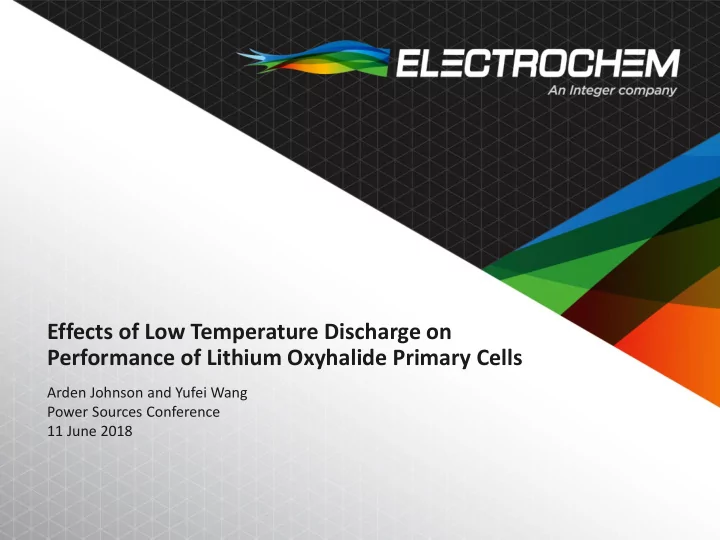

Effects of Low Temperature Discharge on Performance of Lithium Oxyhalide Primary Cells Arden Johnson and Yufei Wang Power Sources Conference 11 June 2018
Outline • Electrochem • Cell testing considerations • Results and discussion • Low and high temperature • Constant current versus constant power • Constant current versus pulsed discharge • Mixed temperature discharge • Acknowledgments 2 Electrochem Confidential
Electrochem Electrochem, based in Raynham, MA, manufactures primary lithium oxyhalide cells with very high energy density for extreme conditions – e.g., high or low temperature, high shock and vibration, long endurance. Electrochem makes three lithium oxyhalide primary chemistries: • Thionyl chloride (SOCl 2 ) OCV = 3.65 V • Sulfuryl chloride (SO 2 Cl 2 ) OCV = 3.93 V • BCX (SOCl 2 + BrCl) OCV = 3.9 V Electrochem also builds primary and secondary battery packs for a range of markets and critical applications where failure is not an option . Below are examples of some of the markets and applications we serve. Energy Military Environmental • Downhole Drilling • Communications • Oceanographic Systems • Pipeline Inspection • Detection • Detection & Monitoring • Seismic Surveying • Avionics • Industrial/Utility 3 Electrochem Confidential
Cell Performance The testing described here covers a range from very low to moderate temperatures typical of those found in military and aerospace, as well as oceanographic applications and pipeline inspection. In many cases, batteries may be stored or used to power up a device at one temperature, but then be required to operate the device at a very different temperature. 4 Electrochem Confidential
Cell Performance Considerations • For real applications, run-time is what matters. • Most cell data-sheets show capacity (Ah) data obtained from discharge under constant current conditions. When the discharge voltage curve is very flat, constant current behaves the same as constant power, and estimating run-time from capacity is straightforward. • If the discharge curve is not flat, then constant current and constant power behavior can be quite different, and calculating run-time is more complicated. • Both capacity and run-time can be very sensitive to the cut-off voltage. Small differences in cut-off voltage can lead to big differences in the capacity and run- time that can be achieved. This is especially true at low temperatures, where running voltages are decreased. 5 Electrochem Confidential
Testing Layout Cells : DD-sized (33.5 mm diameter, 120 mm length), high-rate design Electrolytes : thionyl chloride (TC), sulfuryl chloride (CSC), BCX Temperatures : -55°C, -40°C, -20°C, 0°C, RT (+23°C), +50°C Discharge rates : 500 mA, 1.25 A, 3.6 W Pulsed discharge : 2 A for 1 second, 0.5 A for 59 seconds (average 525 mA) Mixed-temperature conditions : 3.6 W discharge; -40°C for 6 hours, 2 hour ramp to RT, discharge to end-of-life at RT 3.6 W discharge; -40°C for 2 hours, 2 hour ramp to 0°C, discharge to end-of-life at 0°C Sample : Five cells per test condition. 6 Electrochem Confidential
-40°C vs. +50°C 7 Electrochem Confidential
Test Results: Very Low Temperature (-40°C) 8 Electrochem Confidential
Test Results: Moderate/High Temperature (+50°C) 9 Electrochem Confidential
Constant Current vs. Constant Power 10 Electrochem Confidential
Test Results: 0°C, Constant Current (1.25 A) 11 Electrochem Confidential
Test Results: 0°C, Constant Power (3.6 W) 12 Electrochem Confidential
Constant Current vs. Pulsed Discharge 13 Electrochem Confidential
Test Results: 0°C, Constant Current (500 mA) 14 Electrochem Confidential
Test Results: 0°C, Pulsed Discharge (Average 525 mA) 15 Electrochem Confidential
A Summary Some summary points: • BCX is superior to CSC at very low temperatures (-40°C). • Higher capacity does not necessarily lead to longer run-time under constant power conditions. • Both run-time and capacity depend strongly on the cut-off voltage. Pulse voltages can drop below the cut-off even though much cell capacity is still left. What happens if the temperature changes during the discharge? 16 Electrochem Confidential
Test Results: Colder, then warmer (6 hours at -40°C) 17 Electrochem Confidential
Test Results: Colder, then warmer (2 hours at -40°C) 18 Electrochem Confidential
Comment About Multi-Temperature Operation All of these cells can operate at very low temperature, for a time. However, if the cells are discharged to 2.0 V at the low temperature, they may not recover fully when brought up to a higher temperature. 19 Electrochem Confidential
Very low temperature: discharge at -55°C 20 Electrochem Confidential
Acknowledgments Thank you to Keith Anderson of Electrochem for his help in preparing this presentation. 21 Electrochem Confidential
Thank you for your attention! 22 Electrochem Confidential
Recommend
More recommend